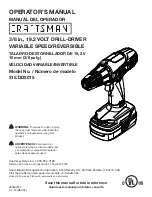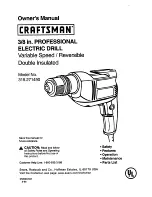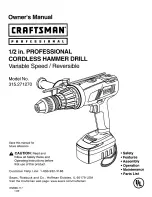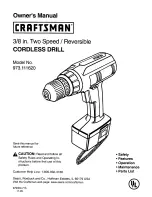
f)
Keep cutting tools sharp and clean.
Properly
maintained cutting tools with sharp cutting edges are
less likely to bind and are easier to control.
g)
Use the power tool, accessories and tool bits etc.,
in accordance with these instructions and in the
manner intended for the particular type of power
tool, taking into account the working conditions and
the work to be performed.
Use of the power tool for
operations different from those intended could result in a
hazardous situation.
5) SERVICE
a)
Have your power tool serviced by a qualified repair
person using only identical replacement parts.
This
will ensure that the safety of the power tool is
maintained.
SAFETY INSTRUCTIONS FOR HAMMER DRILLS
●
Wear ear protectors with hammer drills
(exposure to
noise can cause hearing loss)
●
Use auxiliary handles supplied with the tool
(loss of
control can cause personal injury)
●
Avoid damage that can be caused by screws, nails and
other elements in your workpiece; remove them before
you start working
●
Always keep the cord away from moving parts of the tool
●
When you put away the tool, switch off the motor and
ensure that all moving parts have come to a complete
standstill
●
Use completely unrolled and safe extension cords with a
capacity of 16 Amps (UK 13 Amps)
●
In case of electrical or mechanical malfunction,
immediately switch off the tool and disconnect the plug
●
SKIL can assure flawless functioning of the tool only
when original accessories are used
●
Use only accessories with an allowable speed matching
at least the highest no-load speed of the tool
●
This tool should not be used by people under the age of
16 years
●
Do not work materials containing asbestos
(asbestos
is considered carcinogenic)
●
Take protective measures when during work dust
can develop that is harmful to one's health,
combustible or explosive
(some dusts are considered
carcinogenic); wear a dust mask and work with dust/chip
extraction when connectable
●
Be careful not to drill or drive into areas where electrical
wires may be contacted;
always use auxiliary handle
●
The noise level when working can exceed 85 dB(A);
wear ear protection
●
If the cord is damaged or cut through while working, do
not touch the cord, but immediately disconnect the plug
●
Never use tool when cord is damaged; have it replaced
by a qualified person
●
Always check that the supply voltage is the same as the
voltage indicated on the nameplate of the tool (tools with
a rating of 230V or 240V can also be connected to a
220V supply)
●
If the drill bit becomes unexpectedly jammed (causing a
sudden, dangerous reaction), immediately switch off the
tool
●
Be aware of the forces that occur as a result of jamming
(especially when drilling metals);
always use auxiliary
handle
and take a secure stance
●
Always disconnect plug from power source before
making any adjustment or changing any accessory
WHEN CONNECTING NEW 3-PIN PLUG (U.K. ONLY):
●
Do not connect the blue (= neutral) or brown (= live) wire
in the cord of this tool to the earth terminal of the plug
●
If for any reason the old plug is cut off the cord of this
tool, it must be disposed of safely and not left
unattended
USE
●
On/Off
3
●
Switch locking for continuous use
4
(possible only with
switch D in position
9
a)
●
Speed control for smooth starting
5
●
Maximum speed control
6
With wheel C the maximum speed can be adjusted from
low to high (A-E)
- switch on the tool
- lock the switch
- turn wheel C to select maximum speed
●
2 Mechanical speeds
7
! change speed only when tool is switched off
1 = LOW SPEED
- high torque
- for screwdriving and drilling large diameters
- for tapping thread
2 = HIGH SPEED
- lower torque
- for drilling small diameters
●
For determining the optimal speed table
8
can be used
as reference
●
Changing direction of rotation
9
- when not properly set in left/right position, switch A
2
cannot be activated
! change direction of rotation only when tool is at a
complete standstill
●
Normal drilling/screwdriving versus hammer drilling
0
! select drilling function only when tool is switched
off
●
Changing bits
!
- insert the bit as deep as possible in the chuck
! do not use bits with a damaged shank
●
Adjusting drilling depth
@
●
Holding and guiding the tool
#
! always use auxiliary handle
(can be adjusted as
illustrated)
- keep the ventilation slots uncovered
- do not apply too much pressure on the tool; let the
tool do the work for you
APPLICATION ADVICE
●
Use the appropriate bits
$
! only use sharp bits
●
When drilling ferrous metals
- pre-drill a smaller hole, when a large hole is required
- lubricate drill bit occasionally with oil
7
Summary of Contents for Torro 6490
Page 2: ...6490 1020 W 2 6 kg 1 2 F D B A C G E H H 2 3 4 0 3100 13 50mm 0 1100...
Page 4: ...4 PHILLIPS POZIDRIV SLOTTED 0...
Page 5: ...5 TEN NIS In Deutschland nicht lieferbar 2610073400 ACCESSORIES...
Page 44: ...2 3 e 4 44...
Page 45: ...e 5 a 16 Skil 16 p p p p p 80 dB A 230 240 220 3 4 D 9a 5 6 A E 2 7 1 2 8 9 2 45...
Page 46: ...0 P www skileurope com Skil Skil www skileurope com 2002 96 6490 1 2 A B C D E F G H 1 UA 46...
Page 47: ...b c 2 a b c d e 3 a b c d e f g 4 a b c d e f g 47...
Page 48: ...5 a 16 SKIL 16 85 230 240 220 3 4 D 9a 5 6 A E 2 7 1 2 8 9 2 0 48...
Page 56: ...d e f g 4 b c d e f g 5 p p p 16 A SKIL p p p p p p p 56...
Page 76: ...76...
Page 77: ...77...
Page 80: ......








































